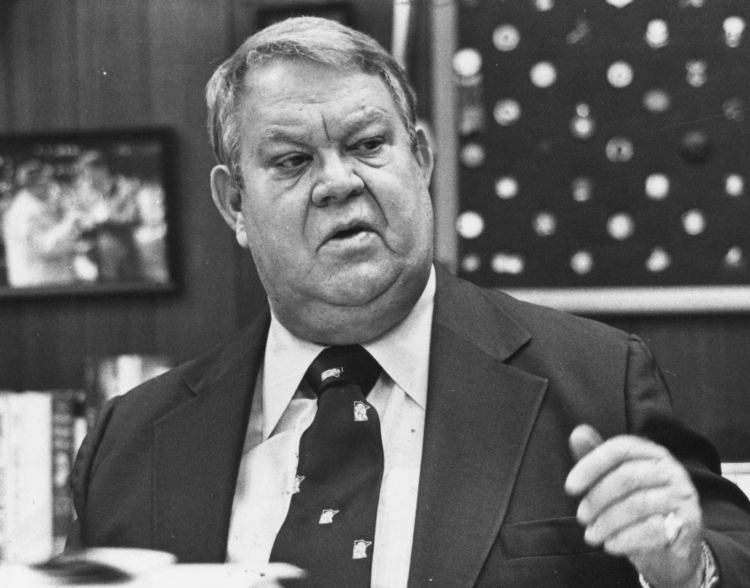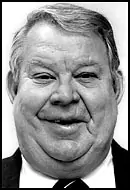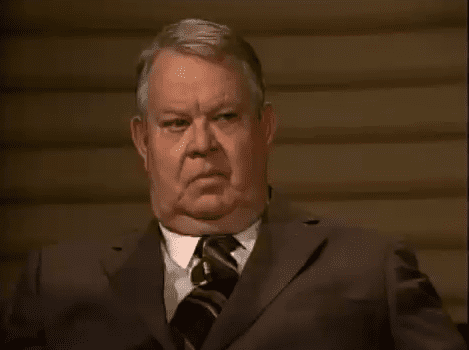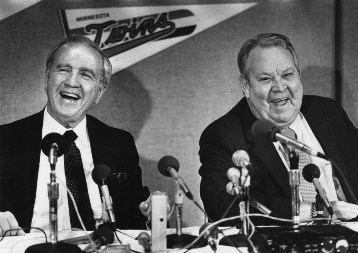Name Calvin Griffith | ||
 | ||
Education | ||
Calvin griffith talks about billy martin
Calvin Robertson Griffith (December 1, 1911 – October 20, 1999), born Calvin Griffith Robertson in Montreal, Quebec, Canada, was a Major League Baseball team owner. As president, majority owner and de facto general manager of the Washington Senators/Minnesota Twins franchise of the American League from 1955 through 1984, he was famous for his devotion to the game and for his sayings.
Contents
- Calvin griffith talks about billy martin
- Wtcn kare sports with jeff passolt tom ryther interviews calvin griffith june 1982
- Childhood in Montreal and Washington
- Washington 195560
- On the field Sluggers and struggles
- Off the field Relocation efforts
- 196170 Contenders and a championship
- 197184 Decline and rebuilding
- Outspoken reputation
- Sale to Pohlad
- References

Wtcn kare sports with jeff passolt tom ryther interviews calvin griffith june 1982
Childhood in Montreal and Washington

Calvin Griffith was the son of James A. Robertson, a native of the Shetland Islands who emigrated to Canada and became a minor league baseball player. Robertson had a tryout with the Montreal Royals of the high minors before his career washed out. Troubled by alcoholism, he died in 1922, leaving a widow and seven young children in Montreal in dire circumstances. But a sister, Anne ("Addie") Robertson, had moved to the United States, where in 1900 she married Clark Griffith, a future Hall of Fame pitcher who became a manager (Chicago White Sox, New York Highlanders, Cincinnati Reds and Washington Senators) during the first two decades of the 20th century and then president and chief stockholder of the Senators after 1920.

Clark and Addie Griffith, who were childless, took in the Robertson family in their Washington, D.C., home in 1923. Clark Griffith raised Calvin from the age of 11, and Calvin and a sister, Thelma, both took on the Griffith surname.
Washington (1955–60)

The senior Griffith owned the Senators until his death in October 1955; the team then passed into the hands of Calvin, who had worked his way up through a variety of positions since the 1920s. He started as a batboy; then, after attending George Washington University in the U.S. capital, he was a minor league player and manager (serving a brief stint under Joe Engel and the Chattanooga Lookouts at Engel Stadium) before he joined the Washington front office, eventually becoming a vice president. Calvin and his sister, now Thelma Griffith Haynes, each inherited half of their uncle's 52 percent stake in the Senators. For the next 29 years, Thelma voted her shares along with her brother's, giving Calvin effective control of the team.

Other Robertson children also would assume important positions with the Senators. Three of Calvin's brothers — Sherry, Jimmy and Billy Robertson — and a brother-in-law, Joe Haynes, would eventually become team executives. Meanwhile, brother-in-law Joe Cronin, a Hall of Fame shortstop married to Mildred Robertson, would serve as playing manager of the Senators and Boston Red Sox, general manager of the Red Sox, and president of the American League.
Under Calvin's ownership, the left-field dimensions of cavernous Griffith Stadium were immediately shortened. Although the distance along the left-field foul line decreased by only 14 feet (4.3 m) to 388 feet (118 m) in 1956, the left-center-field power alley was reduced to 360 feet (110 m); a 6 ft (1.8 m)-high inner fence made the new contour even friendlier to right-handed power hitters. The original dimensions were favored by the late Clark Griffith, who, as a former moundsman, built his successful early 20th-century teams on pitching, speed, gap to gap hitting and defense. The pennant-contending 1945 Senators, who finished in second place by 1 1⁄2 games, hit only one home run (by Joe Kuhel on September 7) in 2,601 home at bats all season. The 1955 Senators hit 20 home runs at Griffith Stadium during their 77-game home schedule.
On the field: Sluggers and struggles
The 1956 club, with the new dimensions in place, slugged 63 long balls at their home park, and Washington clubs of the late 1950s featured powerful right-handed hitters like Roy Sievers, Jim Lemon, Bob Allison and Hall of Famer Harmon Killebrew. Sievers (1957) and Killebrew (1959) would establish a new Senators' single-season home run record, with 42 blasts to lead (or, in Killebrew's case, co-lead) the American League in that category. However, the Washington pitching staff bore the immediate brunt of the changes to the stadium. The 1955 Senators notched a 4.62 staff earned run average; one year later, the staff ERA jumped to 5.33—with an abysmal 5.55 ERA at home. To Griffith's credit, however, his pitching staff (led by ace right-hander Camilo Pascual) began to post respectable earned run averages beginning in 1958 and by 1960, the Senators' ERA was down to 3.77 (3.88 at Griffith Stadium).
Calvin Griffith also invested in Washington's traditionally weak farm system and scouting operations—its successes in scouting Cuba notwithstanding. In 1946, The Sporting News' Official Baseball Guide showed only three full-time scouts on the Senators' org chart; the 1951 edition listed eight. But by 1960, the team's last year in Washington, the same annual listed 23 full-time talent hunters working on the Senators' behalf. The changes to the farm system were less dramatic: the team usually listed 6–8 affiliates throughout the 1950s, and the 1960 Senators actually sponsored one fewer team than the 1951 club. But while Clark Griffith's farm system was concentrated at the lower levels of minor league baseball (for years, Double-A Chattanooga was Washington's top farm affiliate), Calvin added Triple-A affiliates, first in 1956 and then, for good, in 1960. He began to invest, cautiously, in bonus babies, with Killebrew a notable success. The proof of Griffith's success was in the pudding: by 1960, his Senators featured home-grown players like Killebrew, Allison, Pascual, Pedro Ramos, Jim Kaat and Zoilo Versalles. He also obtained young talent like Earl Battey, who would be the team's starting catcher from 1960–67, and power-hitting prospect Don Mincher, both acquired for Sievers in April 1960, and starting pitcher Jack Kralick, signed as a minor league free agent the previous season. The trio came to Washington from the White Sox.
Off the field: Relocation efforts
But the results of Griffith's efforts were initially hard to detect. The 1956–59 Senators averaged 95 losses each season, with three last place finishes in a row (1957–59). Attendance hovered below 500,000 until 1959, when it improved to 615,000. The 1954 relocation of the St. Louis Browns to nearby Baltimore as the Orioles dampened the team's regional appeal, even though the 1950s Orioles were also a chronic resident of the second division. At the 1956 World Series, Griffith, not even a year into his tenure as the Senators' president and majority owner, began preliminary talks with Los Angeles city and county officials about a potential transfer to the West Coast. (Brooklyn Dodgers' owner Walter O'Malley, learning of Griffith's interest and thwarted by New York City officials in his plans to replace his decaying ballpark, Ebbets Field, soon supplanted Griffith as Los Angeles' prime target.) Griffith's main tenants, the Washington Redskins, were poised to abandon Griffith Stadium for the publicly financed District of Columbia Stadium in the fall of 1961. And although the new facility aimed to house Griffith's Senators, too, the team and the district could not agree on rental terms.
Griffith began to discuss relocating his club to the Twin Cities of Minneapolis–Saint Paul in September 1959, but talks stalled. Minnesota-based owners had established a franchise in the new Continental League, and MLB owners were reluctant to antagonize the United States Congress (and jeopardize baseball's exemption from antitrust laws) by removing Washington's home team without a suitable succession plan. As the Senators' future was being debated off the field, the 1960 team enjoyed new on-field success thanks to its young talent base. Although it was still a below-.500 outfit (at 73–81), the Senators rose from eighth and last place to fifth in the league, and attendance exceeded 743,000. But when the 1960 season ended, Griffith was able to come to terms with Minnesota public officials. At same time, the American League seemingly solved the potential antitrust issue (and helped to scuttle the Continental League) by voting to add two new teams for 1961, including an expansion franchise in Washington. The new club, which carried on the Senators' name, started at square one with players discarded from the eight original AL teams; it lost 100 games in 1961, and would have only one winning season (in 1969). In 1972, it moved to Dallas–Fort Worth as the Texas Rangers. Meanwhile, Griffith took his young talent and the historical past of the 1901–60 Senators to the Twin Cities.
1961–70: Contenders and a championship
Just five years after his uncle's death, Calvin Griffith moved the Senators to Minneapolis–Saint Paul in 1961. The renamed Minnesota Twins established residency in suburban Bloomington at Metropolitan Stadium, which had been built five years earlier for the Triple-A Minneapolis Millers and was now expanded to house the MLB Twins. At first the Twins took a step backward, winning only 70 of 160 games in 1961's new, longer American League schedule. But they drew 1.26 million fans, 200,000 more than their most successful season in Washington. (Meanwhile, the Twins' second-largest shareholder, Washington businessman H. Gabriel Murphy, filed suit in federal court seeking to block the franchise shift; his legal battle with Griffith would last for eight years.)
Despite the poor debut of the Twins on the field, Griffith's farm system continued to bear fruit. In 1962 rookie infielders Rich Rollins and Bernie Allen joined the maturing core of the team as the Twins vaulted into second place with 91 wins, only five games behind the New York Yankees. The 1963 edition also won 91 games, but fell further behind the Yankees, placing third, 13 games out, then the 1964 Twins slumped to a below-.500 season (79–83) and seventh place in the ten-team AL. But in 1963–64, Griffith continued to add young players to the Twins' lineup: center fielder Jimmie Hall, first baseman Mincher, and in 1964, AL rookie of the year and batting champion Tony Oliva. Griffith also shrewdly acquired two starting pitchers, Jim Perry and Mudcat Grant, in separate transactions with the Cleveland Indians.
Griffith's efforts came together when the 1965 Twins broke the Yankees' stranglehold and won 102 games and the American League pennant. It was the franchise's first league title since 1933 (and would be Calvin Griffith's only pennant-winner as owner). Versalles was the AL Most Valuable Player, Grant won 21 games and Oliva captured his second straight batting title. Griffith was named Major League Executive of the Year by The Sporting News. In the 1965 World Series, the Twins and the Los Angeles Dodgers split the first six games, with the home club winning every game. But in Game 7 at Metropolitan Stadium, the Dodgers' Sandy Koufax shut out the Twins, 2–0, to deny Griffith a world championship.
The Twins would win 89 or more games for four of the next five seasons. In 1967, they unveiled another brilliant rookie when future Hall of Famer and seven-time AL batting champion Rod Carew became the team's starting second baseman. After a thrilling race, the Twins narrowly missed the 1967 pennant by dropping the season's final two games to the eventual league champion Red Sox. Then, after the American League expanded to 12 teams and two divisions, they won the first two American League West Division championships ever contested for, in 1969 and 1970. But, on both occasions, they fell to the AL East's Orioles, going winless in ALCS competition.
1971–84: Decline and rebuilding
With the exception of future Hall of Famer Bert Blyleven, who debuted as a teenager in 1970, the team's supply of elite minor league talent began to ebb during the 1970s. Oliva and Killebrew battled injuries and age, and the Twins sank back in the standings for the rest of the decade. The striking down of the reserve clause in 1976 meant the family-owned Twins would have to compete with wealthier MLB teams to keep their stars, and some of the club's best young players, such as relief pitcher Bill Campbell and outfielder Lyman Bostock, departed as free agents. Blyleven, only 25, was traded to the Rangers for prospects and cash in June 1976 as he approached free agency. Then, in 1979, facing Carew's imminent free agency—and after the Lions Club debacle (below), when the Twins' owner's seemingly racist remarks enraged the star player—Griffith traded Carew to the California Angels for a package of prospects.
The last five full seasons of Griffith's ownership (1979–83) witnessed only two .500 or better teams, and attendance fell below one million fans at both Metropolitan Stadium and their new home, the Hubert H. Humphrey Metrodome, where the Twins moved in 1982. Behind the scenes, however, the Twins' farm system was stepping up its development of young talent. Griffith's roster in 1984, the year during which he sold the Twins, would include Kirby Puckett, Kent Hrbek, Gary Gaetti, Tim Laudner and Frank Viola, all key members of the Twins' 1987 world championship team.
Outspoken reputation
Famous for his comments ("He'll either be the best manager in baseball — or the worst", he said when he gave a young Billy Martin his first manager job), one of his most infamous landed him in trouble in 1978, drawing charges of racism. Speaking at a Lions Club dinner in Waseca, Minnesota, Griffith was quoted as saying:
"I'll tell you why we came to Minnesota. It was when we found out you only had 15,000 blacks here. Black people don't go to ballgames, but they'll fill up a rassling ring and put up such a chant it'll scare you to death. We came here because you've got good, hardworking white people here."
Sale to Pohlad
In 1984, buffeted by the changes in baseball brought about by free agency, Griffith sold the Twins to Minneapolis banker Carl Pohlad on August 15. The controlling 52 percent of the team's stock held by Griffith and his sister Thelma reportedly fetched $32 million. Murphy's 40.4 percent of the team was sold to Pohlad through the Tampa Bay Baseball Group for a reported $11.5 million. The transaction ended almost 65 years of Griffith family ownership. Griffith wept at the signing ceremony. He stayed on for a time as chairman of the board.
Griffith died on October 20, 1999 at the age of 87. Ironically, he was buried back in Washington, D.C., a city he rarely visited after he moved the Senators to Minnesota, and as a result made him one of the most disliked figures in Washington sports.
Calvin Griffith was inducted into the Canadian Baseball Hall of Fame in 2010.
